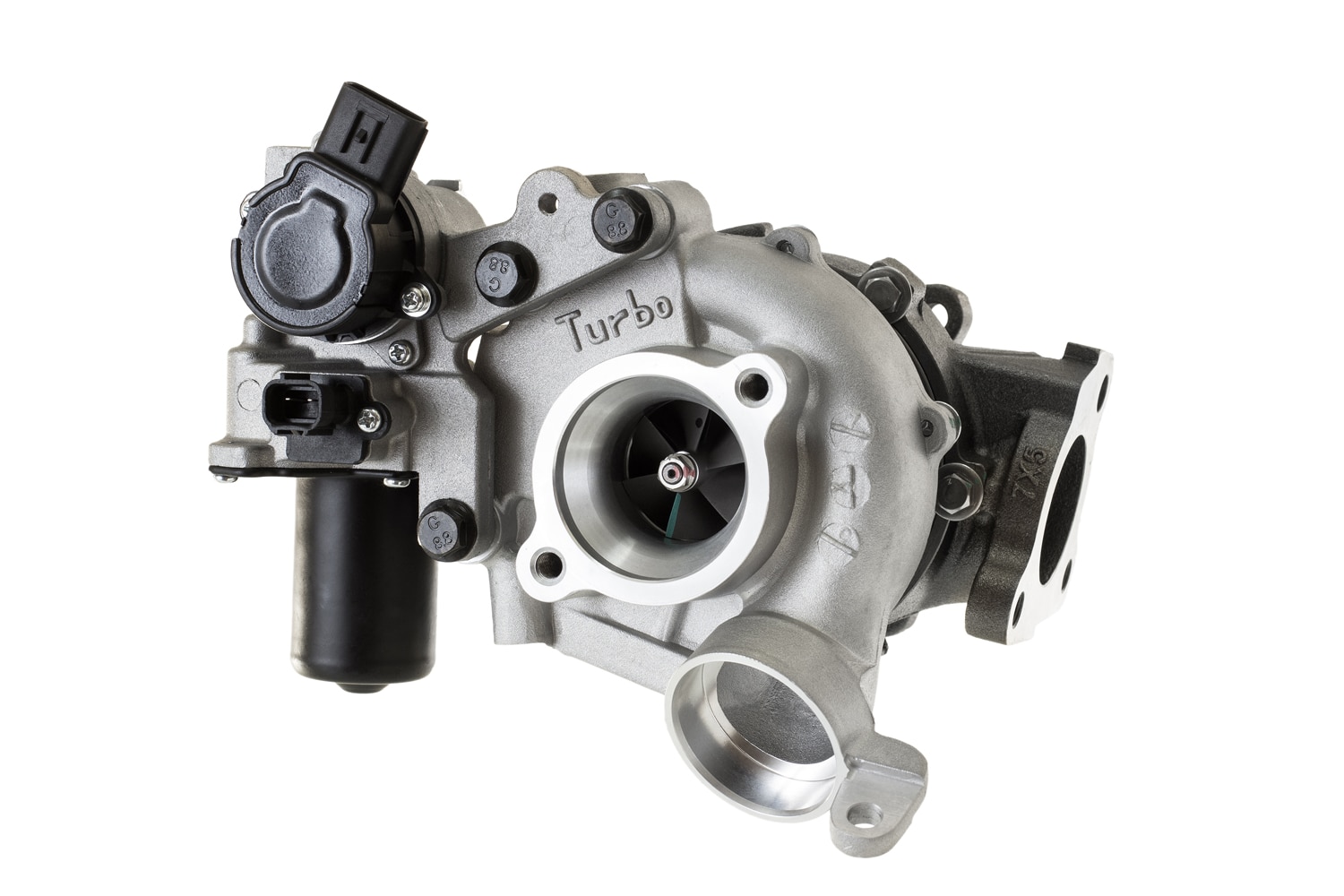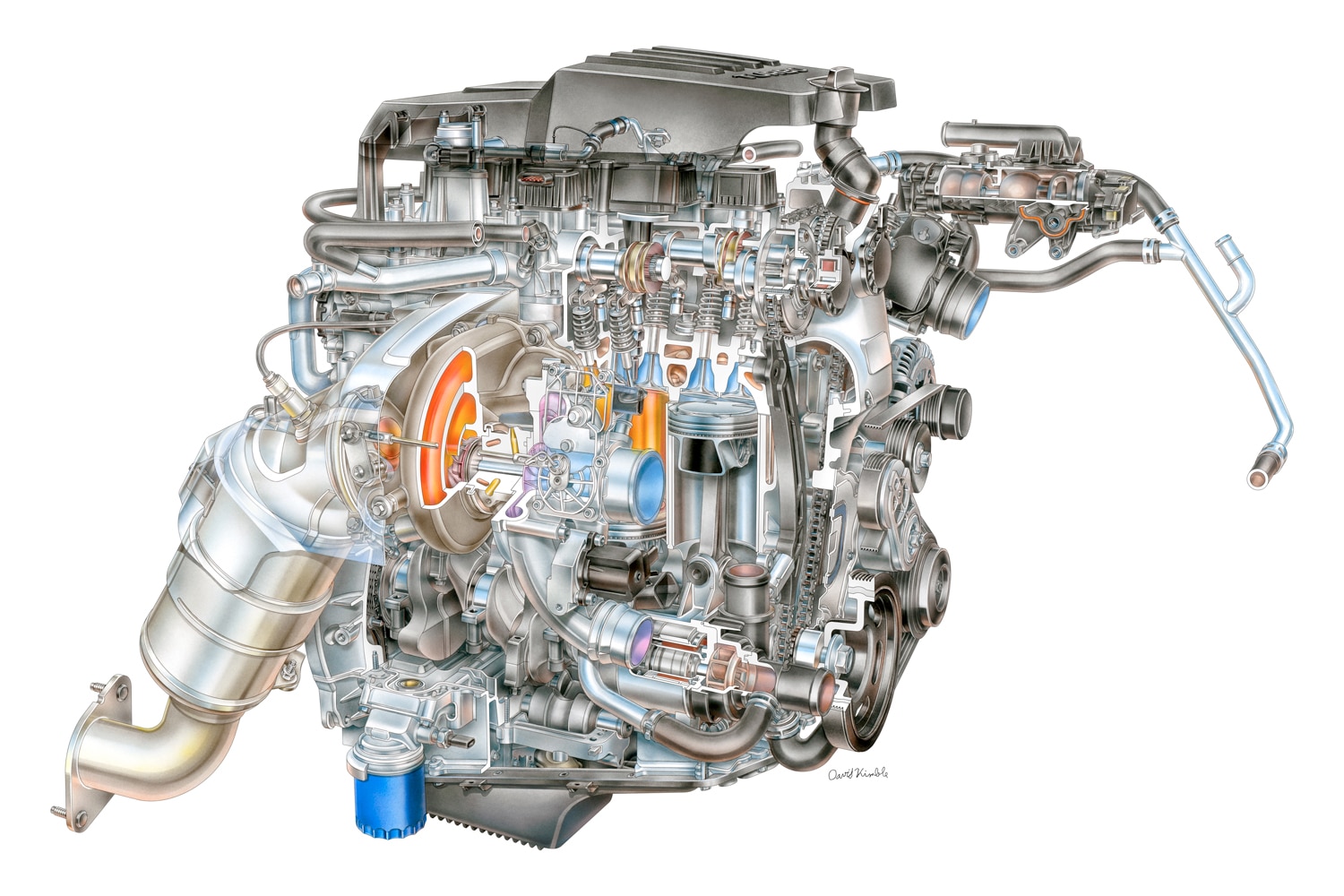What Is a Turbocharger?
This snail-looking air pump helps small engines make big power.

Shutterstock
For decades, automakers have sought to make small engines more powerful by strapping turbochargers to them. These hairdryer-shaped devices—also likened to and sometimes called snails, for their similarity to the creature’s shells—pump more air into the engine and, as a result, create more power. According to the EPA, almost 35 percent of 2020-model-year vehicles had them, and that's on the rise. Here we’ll discuss the basics of how turbochargers work and what they do.
What Is A Turbocharger, and What Does It Do?
Turbochargers compress the air going into the engine—a process known as forced induction. An internal-combustion engine does its job by pulling air and fuel into its cylinders, compressing the mixture with pistons, and igniting it. The resulting explosions push the pistons down, which turn the crankshaft to power the vehicle. The amount of power an engine can make depends on the amount of fuel it can burn, but in order to increase the fuel, you need more air too. That’s where turbochargers come in, forcing more air into the engine than it could otherwise suck in on its own.
Turbochargers provide such a boost in power that automakers are able to downsize engines—reducing displacement and in many cases the number of cylinders—while still making similar power. So a turbocharged four-cylinder can replace a naturally aspirated V6, and a boosted six-cylinder can make V8-level power. Engines without turbochargers are often called naturally aspirated engines when a distinction is necessary.
 Chevrolet
Chevrolet
How Does a Turbocharger Work?
A conventional turbocharger consists of two fan-like wheels inside housings that look like snail shells and connected via a shaft. The engine routes exhaust gas to one of those wheels, known as the turbine, which in turn rotates the other wheel, called the compressor. The compressor pulls in and pressurizes the fresh intake air that is pumped into the engine’s cylinders. As the engine runs and exhaust pressure builds, the turbine spins faster and faster, further compressing the intake air.
Pictured above is the turbocharged four-cylinder base engine in the Chevrolet Silverado. That’s right, the base V6 is gone, and a turbo four cylinder takes its place, offering more horsepower and better fuel economy than the V6 it replaced.
Automakers and auto suppliers have experimented with electric turbochargers or e-turbos. These turbos add an electric motor on the same shaft as the turbine and compressor to capture energy or spin the compressor quicker than the exhaust gases can. Audi says some of its performance vehicles use electric turbochargers, but these are actually electric superchargers by definition, as they are solely powered by an electric motor, not driven by exhaust gases.
Do Turbochargers Improve Fuel Economy?
Although it may seem counterintuitive, equipping an engine with a device that aims to shove more air and fuel into the cylinders can make it more efficient. This comes down to the on-demand nature of a turbocharger: the turbo kicks in only when your right foot makes a big request from the accelerator pedal. In other scenarios, the engine bypasses the turbo and functions as if it weren’t there. That’s when it’s at its most efficient. So while a turbocharged engine can be more efficient than a naturally aspirated one of similar power, fuel economy ultimately depends on who’s driving and how.
The Subaru Legacy provides a perfect example, especially when you look at the 2019/2020 model year changes. Subaru updated the Legacy that year, dropping a 3.6L V6 from the 2019 model in favor of a turbocharged four-cylinder. The V6 made 256 hp and was rated by the EPA to get an estimated 23 mpg combined. The turbocharged 2.4L four-cylinder engine that replaced it was not only smaller in displacement and physical size, it was rated by the EPA to get 27 mpg and it made 260 hp.
Fuel-economy figures don’t tell the whole story, however. The old adage that your mileage may vary applies here. The EPA’s test regimen has limited hard acceleration, meaning the turbo is rarely cramming extra air into the engine. Because of this, vehicles with turbocharged engines tend to miss their EPA ratings in the real world by bigger margins than vehicles with naturally aspirated engines.
Are There Drawbacks to Turbocharging?
In addition to their potential fuel-economy hit, turbocharged engines are more complicated than naturally aspirated engines, which makes them more expensive to purchase and to fix. It takes time for the engine to produce enough exhaust to spin the compressor, so turbo engines don’t make all of their power immediately and can feel sluggish getting moving—a concept called turbo lag. (E-turbos avoid this problem.)
Written by humans.
Edited by humans.
 David Gluckman
David GluckmanDavid Gluckman has over a decade of experience as a writer and editor for print and digital automotive publications. He can parallel park a school bus, has a spreadsheet listing every vehicle he’s ever tested, and once drove a Lincoln Town Car 63 mph in reverse. When David’s not searching for the perfect used car, you can find him sampling the latest gimmicky foodstuffs that America has to offer.
Related articles
View more related articles